The DSP Programs I talked about last time are at the core of the RX-V679. This is where Yamaha’s expertise really shines. But to get to this functionality you need to go through the device’s user interface (UI). Weakness in this part of the design isn’t unique to Yamaha—it seems to be endemic across mid-range audio products. With that caveat, I promised earlier I’d say something about the RX-V679’s remote control. So here goes…
The Remote Control
 I’VE HINTED IN PREVIOUS EPISODES of this adventure that the human interface aspect of Yamaha’s design needs some attention.
I’VE HINTED IN PREVIOUS EPISODES of this adventure that the human interface aspect of Yamaha’s design needs some attention.
The remote control’s a prime example. Something of a let-down, this. A 22x5cm elongated rectangle, 2cms at its deepest point where the compartment houses a pair of AAA batteries, this lightweight plastic device, with more than a touch of Poundland about it, sports no fewer than 66 buttons, most of them so small you’ll need an eagle eye and a Lilliputian finger to ensure you’re pressing the right one. It’s not illuminated, so using it in a darkened room is hit-and-miss for anything except Scene swapping, volume control and flicking through the DSP Programs, functions for which reasonably sized buttons are provided.
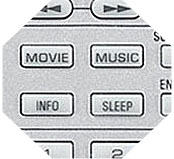 As well as the pair of large buttons provided to cycle through DSP Programs, there’s an additional pair nested among the tiny buttons that divides the DSP Programs into two types: one for those relating to music, and the second for movies.
As well as the pair of large buttons provided to cycle through DSP Programs, there’s an additional pair nested among the tiny buttons that divides the DSP Programs into two types: one for those relating to music, and the second for movies.
And here comes another niggle: a useful convention that’s grown up around equipment over years of experience is that the first press on a button like this that’s going to change the state of a machine doesn’t change the state—it displays the current state. (Even my coffee grinder understands this simple principle.) So I’d expect the first press on either of these buttons to punch up the name of the current Sound Program either on the main unit’s built in LED display or the screen.
Here’s a scenario: You’re listening to a Beethoven string quartet and you think the DSP acoustic sounds a bit too spacious and might be better off placed in the Chamber preset acoustic. So you press the button marked “Music”, and the acoustic immediately switches to the Cellar Club. This will tell the seasoned RX-V679 owner that the DSP was already set to the Chamber preset (because “Chamber” precedes “Cellar Club” in the way the DSP Programs cycle round).
But now you’re in a Jazz club environment, and you have to press the tiny button seven more times to switch through The Roxy Theatre, The Bottom Line, 2 Channel Stereo, 7 Channel Stereo, Hall in Munich, Hall in Vienna before finally cycling back to Chamber.
Yes, there’s an Info button (also tiny) in the row below you’ll probably eventually learn to turn to first: this steps you one button press at a time through information about what’s currently playing, including the compression algorithm used, the title of the current song, the artist, the album and—finally—the DSP environment being applied.
This Info button information only appears on the main unit’s LED display and never on the screen. This may be because it can be punched up on the screen using other buttons (see below), but I’m left with a distinct impression of what Dieter Rams—father of modern design, the brains behind early Braun products and the hero of Apple’s Jony Ive—calls “the arbitrariness with which many things are produced and brought to market”. Not, as I say, that this is by any means unique to Yamaha.
The On-Screen Display
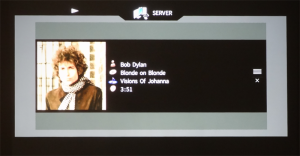 It’s possible to use the remote control while watching the unit’s built in LED front panel, but you’ll find navigation through the options and your media a lot easier in conjunction with the on-screen display that shows up on whatever display device you’ve attached to the HDMI out port.
It’s possible to use the remote control while watching the unit’s built in LED front panel, but you’ll find navigation through the options and your media a lot easier in conjunction with the on-screen display that shows up on whatever display device you’ve attached to the HDMI out port.
This is the display we used when we set up the speakers, but it will also behave as an extension of/alternative to the LED front panel for handling media you’re playing through the RX-V679. For example, if you’re playing a music track which has been properly tagged, the track information you’d have patiently to step through to read off the LED front panel is all displayed here in a single table, alongside any album image associated with the track.
Pressing the remote control button marked On Screen brings up an overlay of information about the RX-V679 itself, sliding in a side panel to the left of screen you can scroll through to find out and change parameters like the DSP Program, Scene, Input currently in use. One such option, Setup, lets you revisit your speaker adjustments, as well as tweaking most of the machine’s other sound, video and network options.
The remote control’s On Screen button is mirrored by a button just marked Option on the right hand side that brings up a panel of audio and video adjustments for fine tuning features like the bass and treble levels. You might be want to use this for sharpening the audibility of dialogue in a movie’s muddy soundtrack (and as well as being able to boost the treble, there’s a separate function that attempts selectively to up the volume of dialogue coming through the middle speaker). Sadly, these changes aren’t tied to the current Scene. They’re global, which means you’ll have to reset them when you go back to playing music.
App & Web Control
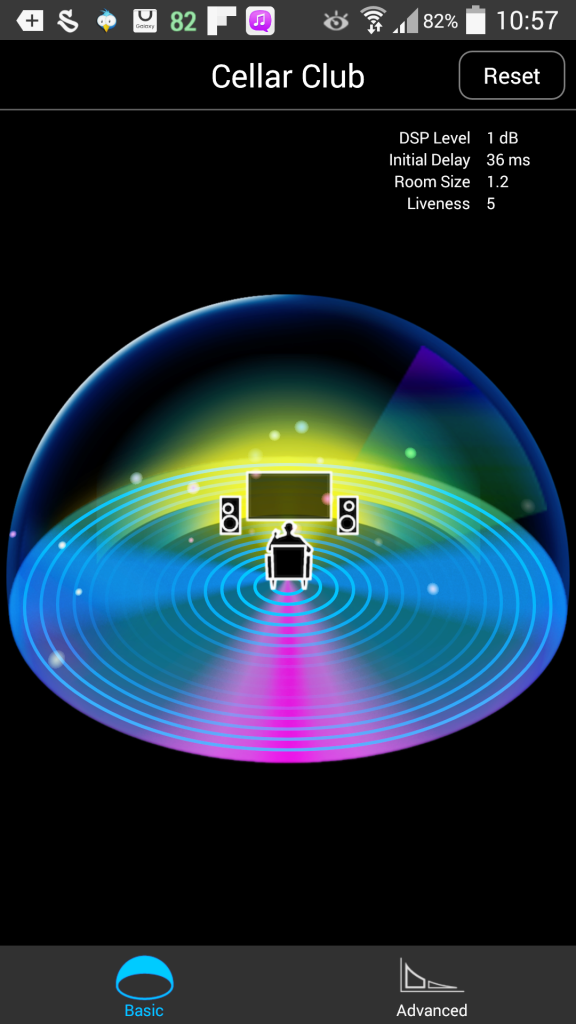
The Basic way of adjusting individual DSP Program settings on Android. The “listening dome” can be zoomed larger or smaller. An Advanced screen allows you to adjust the parameters individually.
If you want to avoid the remote control there are other ways of externally driving the RX-V679. Apps are available for iOS, Android and—laudably—Windows phones.
The Windows phone version is a simple text-based app that covers most of the basics you’ll need. The Android app (and, presumably, the iOS app—I didn’t test it) goes rather further into the capabilities of the AV receiver, for example by offering two different ways of modifying the DSP acoustics of each individual Sound Program (see picture).
As well as piloting the system from a phone or tablet app, you can access the RX-V679 from any computer on the same LAN simply by sticking its IP address into a Web browser. You can get this address from the on-screen Information/Network panel. (But watch out for the stupid trap Yamaha sets for you.)
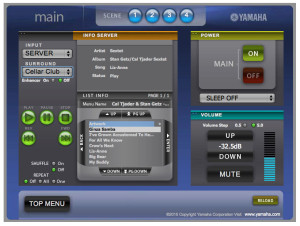
The Web browser offers a series of useful panels that look like this.
You’ll notice from the volume control panel bottom left that this can be adjusted either in 5dB or 0.5dB steps, which I thought was a particularly nice touch. Unfortunately, the Web interface seems not to remember this setting, always re-setting to the larger increment when you reload the page. Which is particularly odd, as the remote control and the unit’s physical volume control knob both operate in 0.5dB steps. The practical importance of this is that 5dB steps sound like distinct jumps in volume, whereas 0.5dB changes are smooth.
Using the RX-V679 to play music from a DLNA Server (more about this in the next and final episode) is straightforward, if perhaps a little too basic. Play a track and the system will continue to play subsequent tracks it finds. While a track is playing you can use the navigation buttons to wander through your collection looking for the next track without interrupting the current stream. But there’s no way of building and/or storing playlists, or even adding chosen tracks to the whatever’s playing at the present.
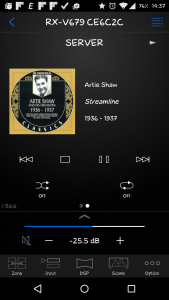
Track details and pause/play control but no playing progress shown on the Android app.
It would be useful if the Web interface showed progress through the track, but this feature is missing from both this presentation and the phone app. The On Screen presentation direct from the unit does manage to display track time expended in minutes and seconds, but without an indication of total track time you get no sense of position. (Some of those Lily Allen remixes just seem to go on for ever.)
The Web interface doesn’t scroll the track title, so if the track is, say, “Mozart Requiem In D Minor, K 626 – 5. Sequentia: Recordare”, all you’ll ever see is “Mozart Requiem in D Minor, …” and you won’t be able to tell from this view which section of the Mass you’re playing. The display panel on the unit will scroll the track title when you cycle to that function using the Info button, but will only do this once, not continuously. Once it’s frozen (in this case reading “Mozart Requie”) you’ll need to press the Info button five more times to get the track title scrolling again.
Other panels presented to the browser give you control over a variety of other functions, like editing the machine’s name on the network, arranging it to switch on via the Web browser, updating the firmware and backing up all the unit’s settings.
To be fair, Yamaha’s designers have a much bigger problem than Dieter Rams faced in those early days of Braun radios. There’s a ton of extra functionality in modern AV receivers, and “surfacing” it (as the jargon goes) to the user is a real challenge.
The phone app meets this challenge much better than the remote control, and rather better than the Web interface. The only function inaccessible to the phone app (for some reason) is the ability to change the algorithm for the Surround DSP Program. The Web interface can’t do this either—if you want to switch the Decode Type between Neo:6 Cinema, Neo:6 Music or the 6 Dolby variants you can only do this through the on-screen menu.
One thing the Web and phone apps could do—but don’t—is give you extra Scene preset buttons. The four Scene buttons on the physical front panel are faithfully echoed in Yamaha’s software controllers. But if you want to add more of these preset Scenes (you will, you will) you can’t. I’m having to share the Scene 3 button between Internet Radio and playback from my NAS. These could very usefully be two separate Scene buttons, and software controllers easily make this possible. Yamaha’s app designers, however, have passed on this opportunity.
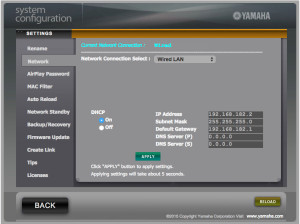 The Web interface has a Settings option. I’ve mentioned inattention to design detail as a recurring problem, and here’s another example (the “stupid trap” I mention above). When DHCP is set to ON, as here, the network details shown in the right hand panel may be completely wrong.
The Web interface has a Settings option. I’ve mentioned inattention to design detail as a recurring problem, and here’s another example (the “stupid trap” I mention above). When DHCP is set to ON, as here, the network details shown in the right hand panel may be completely wrong.
This is actually an edit box, only useable when DHCP is set to off, and in the screenshot you’ll see it’s displaying now obsolete data from last time it was configured. The box as a whole should either vanish when DHCP is on, or (better still) reflect the real current data. (Yamaha, if you’re reading this—this is exactly what Dieter Rams means by “arbitrariness”.)
 Look, Ma—No DAB…
Look, Ma—No DAB…
A prominent feature omitted from the RX-V679 is DAB (Digital Audio Broadcasting). I was a huge fan of DAB when it first appeared in the second half of the 1990s. In the very early days of DAB radio I had an Arcam Alpha 10, a tuner-only unit which in late ‘90s money cost around twice the price of the RX-V679. But the only music you could get out of it during that initial test phase was the cheerful chirrup of birdsong running in a loop. If I remember correctly the birdsong was broadcast at 256kbps, totally fulfilling DAB’s promise of crystal clarity.
Alas, Radio 3 began its DAB broadcasts at a rather tight 192kbps, and still does today (and for a lot of the time it’s even only 160kbps). If you’re thinking in terms of MP3s, bear in mind that DAB in the UK employs the looser MP2 compression, which needs more bandwidth to achieve the same quality. So 196kbps DAB isn’t much better than 128kbps MP3.
Yes, it’s still “crystal clear”, in the sense that it’s free of FM-type transmission interference, but compression artifacts muddy up orchestral music enough to send me back to FM—and now Internet radio. You’ll find an older DAB-enabled AV receiver in Yamaha’s back catalogue, but it’s a feature I’m very happy to pass up. The RX-V679’s FM signal here in North London is interference free and I get clear and consistent reception from my roof aerial.
We’re nearly done with the RX-V679 adventure. Next time I’ll be winding up by talking about Bluetooth and Airplay, and I’ll finally get round to DLNA.
to be continued

Thank you for this very detailed review! If possible – please add some infos on the amplifier section: How many watts per channel are provided when all 5 or 7 channels are driven? The manual only says “… watts for ONE channel …” and this info is useless, because this number drops considerably in real scenarious.
Good question, Nick. As you say, “real scenarios” are certainly going to impact on the manufacturer-provided stats, but the reason manufacturers in general don’t provide these figures is that they’ll vary greatly depending on each particular set up.
I passed this up to Yamaha and got this helpful suggestion back (surprisingly swiftly, actually): “As a guide if you divide the result we give for one channel driven by the number of channels driven then round down a little you will find this result is close to what the actual measured result would be in that specific test condition.”
I realise that before I read your question I’d silently assumed that the 150W or so that manufacturers quote for the power output applied to each channel individually. But a moment’s thought shows you this would suggest that during seven channel use the device would be running at over a kilowatt, like a full-blown gaming computer.
That limitation on per channel wattage is because each independent amplifier shares the DC output from the mains power supply unit.
The other variable is that your particular “real scenario” will seldom have the volume control set for zero dB, and the wattage used of course depends on this setting. Yamaha suggests “…really the best way of measuring a system’s performance is trusting your ears and the dB level you’re hearing. Around 83dB is where you would need to start raising your voice to speak to someone in the same room and is also the reference level a lot of mastering studios use for music.”
Hope this makes sense.
—
Chris
Hi, first of all thank you very much for this review, I have used it to set up my own rxv679. I’ve been trying to decide what speakers to buy for a 5.1 system based on this receiver. Do you have any suggestions? Thanks in advance,
Luca
It’s impossible to advise on speakers without knowing more about the room you want to put them in, and – of course – your budget.
You might be tempted by a cheap 5.1 package deal from your local supermarket. But the RX-V679 deserves better than than. A good place to start looking might be Q Acoustics (https://www.qacoustics.co.uk/). Their 5.1 Home Cinema Packs start at around £450.
—
Chris
Thank you for your time explaining this receiver. Things have come a long way from the purchase of my first system in 1983. I still have a hard time understanding all the features and settings on the new technology.
Just received my Yamaha 679 today which I am mating with a pair of klipsch RF-82ll’s and klipsch 12″ subwoofer to start with. I will be using this for mainly music but will also have it joined with my T.V. adding a center and rears in the future.
I’ve been researching and came up with this set up not knowing if it is the best way to go for my listening pleasure.
It seems everyone I have spoken to has different opinions and advice. I have a 16×26 room this will be in and listen to mainly CD’s and will like to add on my old teac phono from the 80’s.
What is your opinion on my aforementioned set up. I’m trying to find some reassurance or direction.
Seems like all the stores want to push their featured items. I’ve been to 3 stores and gave them the exact same information on what I am looking for in a system and had 3 completely different recommendations.
If you offer paid services for guidance and technological help, let me know.
Knowledge goes a long way and sometimes someone like myself appreciates and needs the knowledge of others, especially when investing money for their pleasure of music.
Thx again for your time.
If I charged for a service of the kind you’re suggesting, Eric, I certainly wouldn’t be happy doing it over the Internet. No-one can advise you sensibly about this without visiting you, standing beside you as you listen to the sort of music you like and discussing how you feel about it.
Your own ears are the most important factor here. Your Klipsch speakers are certainly a cut above my own Harman Kardons. It sounds to me like a great setup.
—
Chris
Hi, I have a quick question and wonder if you could help.
I too have a RX-V679. I am trying to connect it to a home theatre system. The tech assisting with it (remotely) is asking me to provide the ip address showing up in the Yamaha’s network screen with DHCP set to ON. But when my dhcp is set to ON on the yamaha, the ip address field, dns and others are all blank. when the dhcp is set to OFF, it populates with 192.XXX.xx The tech is saying that the DHCP has to be set to ON and then I need to provide the ip addresses.
Do you know how I can get the ip address when DHCP is set to ON, right now, I am getting all blank fields.
Is your RX-V679 wired or wirelessly physically connected to your LAN? Have you tried both?
You’ll appreciate, Ola, that DHCP (Dynamic Host Configuration Protocol) is a client-server arrangement and that your RX-V679 in DHCP client mode is asking the DHCP server on your LAN to provide it with a valid IP address.
Do you know where this DHCP server is? Typically, but not necessarily, it will be in your Internet router. Is it working properly (ie, does it correctly serve IP addresses to other devices on your LAN like wireless connected phones and wired or wireless connected PCs)?
If the answer to the above is “Yes” and you’re sure there aren’t two DHCP servers on your LAN (this can really mess things up), there’s just one other thing I can think of without more information from you:
The DHCP client in the RX-V679 needs to be restarted in order to get it to request its IP address. I seem to remember discovering that the only way to do this restart is to power down the RX-V679 and power it up again. This doesn’t just mean switching it off – you’ll need to unplug it at the mains.
Try that and report back.
—
Chris
Thanks Chris, very much appreciated!
Responses to your questions below:
I tried this setup both wired and wirelessly and in both cases, the dhcp on ON setting didn’t provide any ip addresses. But when it’s on OFF, it gives me this 192.XXX. ip The tech is saying that when it is ON, it should give me ip addresses too.
I would think that the dhcp server is in my router but I am not 100% sure. I logged into my router yesterday just to be sure that it was on dhcp and yet it is- it has a starting and ending ip, both starting with the 192.XXX
I am not sure how to find out if I have more than 1 dhcp server- I only have one internet connection – so not sure. I should mention here that my router is sitting in another room, while this Yamaha is in another room and I am connecting to the wire connection from an outlet in this other room. As I mentioned, I connected my pc (hard wired) to the internet using this same outlet, just to make sure there is an internet connection from this outlet and there is.
Yes, before I sent you the post, I powered down the rx-v679 and on restarting it gave me a note that there was an upgrade firmware that needed to be installed. I am guessing this won’t have happened if the receiver wasn’t connected to the internet. It was wired to the internet before and after I restarted the system.
Not sure what to do from here really. Do you think I can get more information using my laptop i.e. about this dhcp server maybe there is a 2nd one (not sure how this can be possible though) since I only have one internet server- so stumped here.
Thanks!
Your LAN constitutes a private sub-net comprising a set of addresses, of which, in all probability, the first three numbers of the four-part address are significant. Something like 192.168.0.xxx. (Typically that third number may also be a 1). It’s important that all the devices on your LAN should have addresses beginning with those same three numbers. This is the typical domestic arrangement.
It’s important to know these three numbers and to ensure that all the devices on your LAN have addresses beginning the same way. Can you check this by, say, connecting a phone wirelessly (or a laptop either way) to your LAN? Get back to me.
—
Chris
Hello Chris. Thank you for a very enjoyable and informative read. I’ve owned the rx v679 for a few months now and I love it. One of the reasons I went for this unit was the apparent ability to tinker with the EQ more accurately than just the simple +/- treble or bass. The reason for this being a hearing impairment due to 35 years of heavy rock concerts and whole weekends spent in techno night clubs, all great fun at the time but it has left me with a slight reduced hearing of frequencies (roughly) between 2500Hz and 3500Hz. I’ve muddled my way through the instruction manual but it’s quite lacking in detail as to how to utilise this EQ feature fully. I’d really love it if you are still willing to continue your review and include a (an idiots) guide to the EQ.
All the very best and again thanks for the tips you’ve already covered.
Crispian
Crispian, thanks for your kind comments.
I’m not sure I can help much on the basis of what you tell me. You’ve probably already found the Option button on the remote control. This should pop up the Option panel on the screen, which gives you access to a fairly simplistic Treble and Bass control that works globally across all the inputs (I’d much prefer being able to trim each input individually). I have the treble boosted and the base cut to suit my own ageing ears, and also use the Option panel to increase the dialogue level for movies.
Other than that, you can of course use Setup/Speaker/Manual Setup to fine tune the levels of the individual speakers. Any more twiddling and balancing that this would need extra hardware.
—
Chris
Thanks for a great review, and I’ve been having fun figuring this guy out. The sound is amazing, I have a Bose 3-in-1 speaker system, so I use 5.1 and 2 channel stereo and the sound is nice and crisp, too crisp actually, so I boosted the bass a bit. Anyway, when we will see your next iteration?
Sorry to have taken ages to reply, Peter. Many thanks for the compliment.
By “next iteration” do you mean RX-V679 part 6? That went out yonks ago, and I’m sure you’ve read it by now. If, instead, you’re suggesting I start reviewing the current Yamaha RX-V series—no, that’s not on my current review list.
—
Chris
Thanks Chris, maybe I’m a bit behind…I’ve also figured out with my Bose 3-in-1 speaker system, that the best sound is when I use the Surround Decoder.
Have a good one.
Had this amp from new, but the ARC hdmi out has failed, so hdmi to tv, then optical from pc to amp.
Obviously no onscreen control, is there another way to set individual speaker levels?
Sorry to hear that. ARC is the audio return channel you say has failed, but without more information I can’t think of anything useful to say about this. As I’ve suggested to other readers, your best option would probably be to tackle simon.harknett@music.yamaha.com about this. If he can’t help you directly he may be able to connect you with a Yamaha engineer who can.
Let us know how you get on.
—
Chris